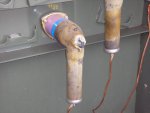aelectricalman
Senior Member
- Location
- KY
View attachment C0602-12.BMP
I'm looking for some common reasons why there would be a situation like this. Could the isolators be bad? Notice this is bonded and there looks to be some bleeding. Im not familiar enough with the insides to know if there could be something else going on. thanks for any help.
Click on the link to see the infared pic.

I'm looking for some common reasons why there would be a situation like this. Could the isolators be bad? Notice this is bonded and there looks to be some bleeding. Im not familiar enough with the insides to know if there could be something else going on. thanks for any help.
Click on the link to see the infared pic.
Last edited:
